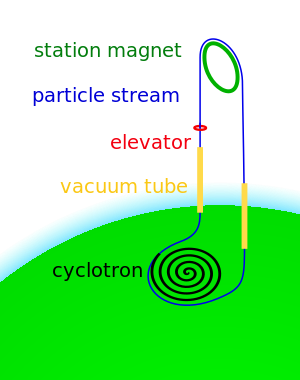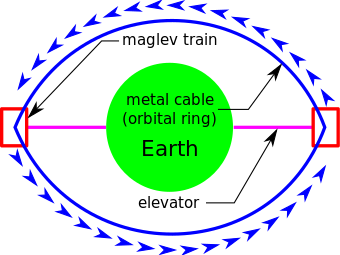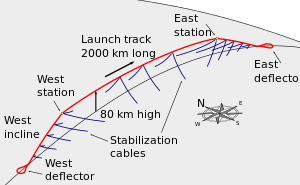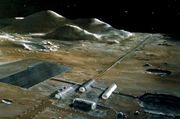الإنطلاق الفضائى اللاصاروخى
الإنطلاق الفضائى اللاصاروخى (NRS) هى فكرة الوصول يصل الى الفضاء الخارجى بالتحديد من سطح الأرض يغلب عدم استخدام المواد الكيميائية والصواريخ التقليدية, وهى اليوم هى الطريقة الوحيدة المستخدمة.
النقل إلى المدار وغالبا ما يكون العامل الذى يحد من الجهود في مجال الفضاء. وقد ذكر في "التوصل الى مدار أرضي منخفض و أنت في منتصف الطريق إلى أى مكان”. وهكذا فإن الوصول الى مدار أرضى منخفض (LEO) هو المفتاح. في هذا اليوم إن تكاليف إطلاق السفن الفضائية مرتفعة للغاية — $10,000 تصل الى $25,000 لكل كيلوجرام من الأرض الى أدنى مدار فضائى LEO, ولهذا فإن بعض البلدان تدعم البلدان التي تطلق بأسعار أكثر قربا $4000. لإستعمار الفضاء, e.g. إستكشاف الفضاء و إستعمار الفضاء , much cheaper launch methods are required, as well as a way to avoid serious damage to the atmosphere from the thousands, perhaps millions, of launches required. Another benefit may be increased safety and reliability of launches, which, in addition to lower cost, would avail for space disposal of radioactive waste.
Many alternatives to conventional chemical rockets have been proposed, which, in turn has inspired many notable combinations.
. . . . . . . . . . . . . . . . . . . . . . . . . . . . . . . . . . . . . . . . . . . . . . . . . . . . . . . . . . . . . . . . . . . . . . . . . . . . . . . . . . . . . . . . . . . . . . . . . . . . . . . . . . . . . . . . . . . . . . . . . . . . . . . . . . . . . . . . . . . . . . . . . . . . . . . . . . . . . . . . . . . . . . . .
مقارنة
| الطريقة(a) | منشورات السنة |
تكلفة الإنشاء المتوقعة غى $B(b) |
الحمولة Size kg |
التكلفة المحتملة الى LEO $/kg(b) |
القدرة بالأطنان المترية في العام |
المعروفة Showstoppers |
مستوى جاهزية التقنية |
|---|---|---|---|---|---|---|---|
| الصواريخ التقليدية[1] | 450 ألى 24k | 10k ألى 25k | No | 9 | |||
| البرج الفضائى | Yes (compression) |
? | |||||
| المصعد الفضائى | نعم (كابل) |
2-4 | |||||
| هايبرسونك سكاى هوك[2] | 1993 | <1(c) | 1500(d) | 30(e) | No | 2 | |
| Rotovator[3] | 1977 | No | 2 | ||||
| HASTOL[4], [5] | 2000 | 15000(f) | No | 2 | |||
| اطلاق طائرة ورقية[6] | 2005 | No | 2 | ||||
| النافورة الفضائية | No | 2+ | |||||
| الحلقة المدارية[7] | 1980 | 15 | 0.05< | No | 2 | ||
| دورة الإطلاق[8] (small) | 1985 | 10 | 5000 | 300 | 40,000 | No | 2+ |
دورة الإطلاقخطأ استشهاد: وسم <ref> غير صحيح؛ أسماء غير صحيحة، على سبيل المثال كثيرة جدا (large) |
1985 | 30 | 5000 | 3 | 6,000,000 | No | 2+ |
| السائق المتعاظم | No | 4 | |||||
| رام معجل | No | 6[9] | |||||
| القذيفة الفضائية | 1865(g) | No | 6 | ||||
| Slingatron[10] | 100 | No | 2 | ||||
| الطائرة الفضائية | No | 7 | |||||
| الدفع الليزرى | No | up to 4 | |||||
| المنطاد المداري | ? | 1-2 |
(a) الإشارات الواردة في هذا العمود تنطبق على كامل الصف مالم ينص على خلاف ذلك
(b) جميع القيم النقدية في غير مبالغ دولار على أساس مرجعية تاريخ نشره ماعدا ماتم الإشارة إليه
(c)CY2008 تقدير من وصف النظام المرجعي في عام 1993
(d) Requires first stage to ~5 km/s
(e) Subject to very rapid increase via bootstrapping
(f) Requires Boeing proposed DF-9 vehicle first stage to ~4 km/s
(g) Jules Verne's novel, From the Earth to the Moon. Newton's cannonball in the 1728 book A Treatise of the System of the World was considered a thought experiment.[11]
الهياكل الضغطية
البرج الفضائى

البرج الفضائى هو البرج الذى يصل الى الفضاء الخارجى . و هل يحل تماما مكان القدرة الصاروخية, و هذا البرج يتجاوز فوق 100 كم خط كرمان (وهو مصطلح شائع يشير الى الفضاء الخارجى) حيث الطريق الى المدار المتزامن مع الأرض بسرعة تقريبية 36,000 كم. أي شيء يسقط من هذا الارتفاع يمكن بعد ذلك ان يكتسب السرعة بأقل قدرة متاحة. أن الأمر الخاص بشيىء يتم إطلاقه ليصل الى المدار المتزامن مع الأرض لأول مرةأعلن من قبل كونستانتين تسيلكوفسكى ,[12] الذي اقترح هيكل ضغط ، أو "برج Tsiolkovsky."
A parallel-sided structure made of conventional brick and stone cannot reach past 2000 meters as bricks at the bottom would be crushed under the weight. A tapered structure could reach higher, but would not make it out of the atmosphere before toppling.[13] Advanced materials would still not allow the tower to reach a usable height. A tower could form one component of a successful launch system, such as being the base station of a space elevator, or a support pillar for the distal part of a mass driver or the "gun barrel" of a space gun.
There are a number of other options to consider for building space towers: rigid, inflatable, kinetic, electrostatic, electronic structures (see noted books above and references below).
هياكل الشد
الهياكل المشدودة أو هياكل الشد للإنطلاق الفضائى اللاصاروخى, مقترحات لاستخدام كابلات طويلة قوية جدا (تعرف الحبال) لجر حمولة إلى الفضاء ,أو قذف شيىء أو نحو ذلك إلى الفضاء,إن إرسال طائرة فضائية بإستخدام هذه الوسيلة طائرة الدفع الفضائى إذ قد تكون استخدام هذه المركبة الفضائية أقل كلفة من سفينة فضائية تعمل بمحرك صاروخى. Tethers ويمكن أن يستخدم أيضا لتغيير المدار مرة واحدة في الفضاء.
Orbital tethers can be tidally locked (skyhooks) or rotating (rotovators). They can be designed (in theory) to pick up the payload when the payload is stationary or when the payload is hypersonic (has a high but not orbital velocity).
Endo-atmospheric tethers can be used to transfer kinetics (energy and momentum) between large conventional aircraft (subsonic or low supersonic) or other motive force and smaller aerodynamic vehicles, propelling them to hypersonic velocities without exotic propulsion systems.
Skyhooks
A skyhook is a tidally locked tether, i.e., it rotates once each time it orbits around a planet or moon.
An example use of a skyhook is that a payload, launched from the ground, can be attached to the base of the skyhook, which is then carried to orbit. This means that a single stage to skyhook approach can be employed, and a high Isp drive or propellantless electromagnetic tether can be used to make up the momentum debt of the payload- or payload flow can be balanced from the moon.
Space elevator
A space elevator a.k.a. beanstalk or "synchronous skyhook" is a stationary skyhook. It focuses on tensile structures (tethers) reaching from the ground to geosynchronous orbit.
The most common proposal is a tether, usually in the form of a cable or ribbon, spanning from the surface near the equator to a point beyond geosynchronous orbit. Neglecting perturbations, it would be possible to design such a tether to barely touch the ground while remaining in orbit. All proposals however have additional ballast placed at the two ends to provide stability. As the planet rotates, the inertia at the upper end of the tether counteracts gravity, and keeps the cable taut. Vehicles can then climb the tether and reach orbit without the use of rocket propulsion. Such a structure could hypothetically permit delivery of cargo and people to orbit at a fraction of the cost of launching payloads by rocket.
Current technology is not capable of manufacturing materials that are sufficiently strong and light enough to build an Earth based space elevator as the total mass of conventional materials needed to construct such a structure would be far too great. Recent proposals for a space elevator are notable in their plans to use carbon nanotube-based materials as the tensile element in the tether design, since the theoretical strength of carbon nanotubes appears great enough to make this practical.
Another difficulty includes shielding the passengers from the Van Allen belts which would require extremely heavy and comprehensive shielding to prevent significant health issues such as cancer and may prevent manned launch for quite some time irrespective of the other issues.
Current technology may be able to support elevators in other locations in the solar system however, and other designs for space elevators exist that use current materials.
A partial space elevator can also be less than the full length from orbit to the surface[14] Subsystems for an orbiting space elevator have been demonstrated with the X-43[2] and TIPS [3] flights.
Hypersonic skyhook
A hypersonic skyhook is a relatively short tether that reaches from just above the edge of space to its design length.
Without the two end ballasts, a space elevator would still be in geosynchronous orbit, and thus stationary relative to the ground. If that tether were to be shorter and still reach the surface, the center of gravity would need to drop also. This would cause the lower tip to have a velocity in the orbital direction. The shorter the tether is, the faster becomes the lower tip velocity. With higher tip velocity, lower material properties are needed to make a practical design but the less benefit is obtained from this method. Eventually, any such design becomes a balance between the expense of providing the velocity to the payload at pick-up and the expense of launching the mass of the tether and power plant as dictated by available materials. Also, the lower tip is raised out of the atmosphere to avoid heating problems.
A reference design was published [2] using materials similar to Spectra 2000 and relying on one Titan IV launch to orbit a fully functional hypersonic skyhook. To keep the tether weight within the launch capacity, a payload pick-up velocity of 5 km/s was assumed. Though the reference design was limited to an Initial Operating Condition of 1,500 kg payload size, at a maximum rate of about one payload each 17 days, the prime limitation to higher capacity was power plant size. One launch of additional power plant would almost double the available power and capacity.
The problem is getting the payload to the altitude (100 km) and velocity (5 km/s) required for pick-up.
Rotovators
A rotovator is a tether that rotates more than once each time it orbits around a planet or moon. Rotovators rotate in the same sense as they orbit such that the lower tip has a retrograde motion relative to the center of gravity.
Rotovators in almost all ways have the same benefits as skyhooks. However, due to the retrograde velocity, the lower tip can achieve a specified Mach number with a shorter tether. This, despite the rotational forces, produces lower stresses in the tether so that lower strength to weight ratio materials can be used for the same results.
Stationary rotovators
A stationary rotovator implies only that the retrograde velocity of the tip fully cancels the orbital velocity. To a stationary payload, it appears as though the tether tip decelerates as it drops straight down from the sky, and then accelerates back upward. The payload must grapple the tip of the tether during that short duration when the tip has come to a stop. Hans Moravec's description of this was "a satellite that rotates like a wheel."[3]
. . . . . . . . . . . . . . . . . . . . . . . . . . . . . . . . . . . . . . . . . . . . . . . . . . . . . . . . . . . . . . . . . . . . . . . . . . . . . . . . . . . . . . . . . . . . . . . . . . . . . . . . . . . . . . . . . . . . . . . . . . . . . . . . . . . . . . . . . . . . . . . . . . . . . . . . . . . . . . . . . . . . . . . .
Hypersonic rotovator (HASTOL)
Similar to a hypersonic skyhook, a hypersonic rotovator uses a much shorter tether than its stationary equivalent and picks up its payload at hypersonic speeds. The Hypersonic Airplane, Space Tether, Orbital Launch (HASTOL) is one design for a hypersonic rotovator.
Endo-atmospheric tethers
An endo-atmospheric tether uses the long cable within the atmosphere to provide some or all of the velocity needed to reach orbit. The tether is used to transfer kinetics (energy and momentum) from a massive, slow end (typically a large subsonic or low supersonic aircraft) to a hypersonic end through aerodynamics or centripetal action. The Kinetics Interchange TEther (KITE) Launcher is one proposed endo-atmospheric tether.[6] A KITE Launcher can be single stage, achieving ~Mach 6 at release; augmented, achieving ~Mach 12 at release, or multi stage, achieving up to orbital.
Dynamic structures
Space fountain
A space fountain is a proposed form of space elevator that does not require the structure to be in geosynchronous orbit, and does not rely on tensile strength for support. In contrast to the original space elevator design (a tethered satellite), a space fountain is a tremendously tall tower extending up from the ground. Since such a tall tower could not support its own weight using traditional materials, massive pellets are projected upward from the bottom of the tower and redirected back down once they reach the top, so that the force of redirection holds the top of the tower aloft. Satellite payloads ascend or descend by coupling with this stream of pellets or by climbing up the side of the tower. The space fountain has several key advantages over a space elevator in that it doesn't require materials with extreme strength, can be located at any point on a planet's surface instead of just the equator, and can be raised to any height required. Its major disadvantage is that it is an active structure, and so requires constant power input to remain aloft.
Orbital ring
An Orbital Ring is a concept for a space elevator that consists of a ring in low earth orbit that rotates at slightly above orbital speed, that has fixed tethers hanging down to the ground.
The first design[بحاجة لمصدر] of orbital ring offered A. Yunitsky in 1982 [15]. Later the other design suggested and research A.Bolonkin in World Space Congress - 2002.
In the 1982 Paul Birch JBIS design[16] of an orbital ring system, a rotating cable is placed in a low Earth orbit, rotating at slightly faster than orbital speed. Not in orbit, but riding on this ring, supported electromagnetically on superconducting magnets, are Ring Stations that stay in one place above some designated point on Earth. Hanging down from these Ring Stations are short space elevators made from cables with high tensile strength to mass ratio. Paul Birch found that since the Ring Station can be used to accelerate the orbital ring eastwards as well as hold the tether, it is possible to deliberately cause the orbital ring to precess around Earth instead of staying fixed in inertial space while the Earth rotates beneath it. By making the precession rate large enough, the Orbital Ring can be made to precess once per day at the rate of rotation of the Earth. The ring is now "geostationary" without having to be either at the normal geostationary altitude or even in the equatorial plane. This means that using the orbital ring concept, a Ring Station can be positioned above any point on Earth that is desired, and anywhere on the globe can be served by a space elevator instead of just the equator. A network of orbital ring systems crossing, for example, at the poles, could cover the whole planet with an array of elevators and geostationary ring stations.
Launch loop
A launch loop or Lofstrom loop is a design for a belt based maglev orbital launch system that would be around 2000 km long and maintained at an altitude of up to 80 km (50 mi). Vehicles weighing 5 metric tons would be electromagnetically accelerated on top of the cable which forms an acceleration track, from which they would be projected into Earth orbit or even beyond.
The published cost estimates for a working launch loop are significantly lower than a space elevator, with a greater launch capacity, lower payload costs and similar or greater payload masses; and unlike the space elevator no new materials need to be developed.
However, it would constantly need around 200 MW of power to keep it in place, such as could be produced by a collection of Stirling engines, similar to what PGE is awaiting regulatory approval to deploy in California [17] with an added scaled up BESS battery facility for night-time operation, such as is now used in Alaska to assure continued electrical power in the event of power plant or transmission line equipment failure. [18]
The system is designed to be suitable for launching humans for space tourism, space exploration and space colonization with a maximum of 3g acceleration [19].
Projectile launchers
With any of these projectile launchers, the launcher gives a high velocity at, or near, ground level. In order to achieve orbit, the projectile must be given enough extra velocity to punch through the atmosphere. Also, the projectile needs either an internal or external means to perform orbital insertion. The designs below fall into three categories, electrically driven, chemically driven, and mechanically driven.
Electric
Mass driver
A mass driver is basically a very long and mainly horizontally aligned launch track for spacelaunch, targeted upwards at the end.
It would use a linear motor to accelerate payloads up to high speeds. All existing and contemplated mass drivers use coils of wire energized by electricity to make electromagnets. Sequential firing of a row of electromagnets accelerates the payload along a path. After leaving the path, the payload continues to move due to inertia.
. . . . . . . . . . . . . . . . . . . . . . . . . . . . . . . . . . . . . . . . . . . . . . . . . . . . . . . . . . . . . . . . . . . . . . . . . . . . . . . . . . . . . . . . . . . . . . . . . . . . . . . . . . . . . . . . . . . . . . . . . . . . . . . . . . . . . . . . . . . . . . . . . . . . . . . . . . . . . . . . . . . . . . . .
Rail Gun
A rail gun is a pair of conductive rails with a projectile between them. A high current passes to and from the projectile through the rails, and through an armature at the back of the projectile between the parallel rails. The interactions between the electrical and magnetic fields accelerate the projectile.
Chemical
Space gun

A space gun is a method of launching an object into outer space using a large gun, or cannon.
However, even with a "gun barrel" through both the Earth's crust and troposphere, the g-forces required to generate escape velocity would still be more than what a human tolerates. Therefore, the space gun is restricted to freight and ruggedized satellites. Also, the projectile needs either an internal or external means to stabilize on orbit.
Blast wave accelerator
A blast wave accelerator very similar to a space gun but it differs in that rings of explosive along the length of the barrel are detonated in sequence to keep the accelerations high. Also, rather than just relying on the pressure behind the projectile, the blast wave accelerator specifically times the explosions to squeeze on a tail cone on the projectile, as one might shoot a pumpkin seed by squeezing the tapered end.
Ram Accelerator
A ram accelerator also uses chemical energy like the space gun but it is entirely different in that it relies on a jet-engine-like propulsion cycle utilizing ramjet and/or scramjet combustion processes to accelerate the projectile to extremely high speeds.
It is a long tube filled with a mixture of combustible gasses with a frangible diaphragm at either end to contain the gasses. The projectile, which is shaped like a ram jet core, is fired by another means (e.g., a light gas gun) supersonically through the first diaphragm into the end of the tube. It then burns the gasses as fuel, accelerating down the tube under jet propulsion. Other physics come into play at higher velocities.
Mechanical
Slingatron
In a slingatron, projectiles are accelerated along a rigid tube or track that typically has circular or spiral turns, or combinations of these geometries in two or three dimensions. A projectile is accelerated in the curved tube by propelling the entire tube in a small-amplitude circular motion of constant or increasing frequency without changing the orientation of the tube, i.e., the entire tube gyrates but does not spin.
This gyration continually displaces the tube with a component along the direction of the centripetal force acting on the projectile, so that work is continually done on the projectile as it advances through the machine. The centripetal force experienced by the projectile is the accelerating force, and is proportional to the projectile mass.
Reaction drives (jets and unconventional rockets)
Spaceplanes
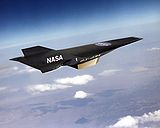
A spaceplane is an aircraft designed to pass the edge of space. It combines some features of an aircraft with some of a spacecraft. Typically, it takes the form of a spacecraft equipped with aerodynamic surfaces, one or more rocket engines, and sometimes additional airbreathing propulsion as well.
As of today, spaceplanes have only been helpful with assisting rocket-driven vehicles through the first distance towards outer space (e.g. Scaled Composites White Knight) and exploring of hypersonic flight (e.g. X-15).
Some air-breathing engine-based designs (c.f. X-30) could potentially achieve orbital velocity; however, these designs still must perform a final rocket burn at their apogee to circularize their trajectory to avoid returning to the atmosphere.
Other, reusable turbojet designs like Skylon which uses precooled jet engines up to Mach 5.5 before employing rockets to enter orbit appears to have a mass budget that permits a larger payload than pure rockets while achieving it in a single stage.
Laser propulsion
Laser propulsion is a form of Beam-powered propulsion where the energy source is a remote (usually ground-based) laser system. This form of propulsion differs from a conventional chemical rocket where both energy and reaction mass come from the solid or liquid propellants carried on board the vehicle.
The concept of laser propelled vehicles was first introduced by Arthur Kantrowitz in 1972.
Combination systems
All these methods can be combined in interesting ways. For instance, some have suggested using projectile launchers to provide fuel in flight to reaction drives which in essence gives the fuel an infinite specific impulse. Another combination is to use a projectile launcher to simply provide kinetic transfer to a catcher. This second one is akin to a dynamic structure except it isn't permanent. A third method might involve a mass driver boosting engine-equipped craft into orbit, as seen in Gundam SEED.
الهامش
- ^ "سبايسكاست 2020" تقرير من قائد الفريق في القوات الجوية , 22 يونيو94.
- ^ أ ب "هايبرسونك سكاى هوك," العلم التناظرى خيال علمى/حقيقة علمية, Vol. 113, No. 11, سبتمبر 1993, pp. 60-70.
- ^ أ ب "وهناك غير متزامن مدار سكاى هوك," Hans P. Moravec, مجلة العلوم للملاحة الفضائية, Vol. 25, Oct-Dec 1977
- ^ Paper, AIAA 00-3615 "تصميم ومحاكاة الحبل المرافق اهاستول HASTOL البنية" R. Hoyt, 17-19 Jul 00.
- ^ Paper, NIAC 3rd Ann. Mtg, NIAC Subcontract No. 07600-040, “Hypersonic Airplane Space Tether Orbital Launch – HASTOL”, John E. Grant, 6 Jun 01.
- ^ أ ب جونسون, US Patent #6913224, طريقة ونظام لتسريع شيىء , 5 يوليو 05
- ^ "نظم الحلقة المدارية و سلالم جاكوب - I-III" Note: في 1980 أموال
- ^ Launch حلقة لشرائح ISDC2002 conference
- ^ [1]
- ^ "Slingatron, A Mechanical ميكانيكي الفائق السرعة سرعة متعاظمة"
- ^ vectorsite.net > [4.0 Space Guns] v1.1.4 / chapter 4 of 7 / 01 jun 08 / greg goebel / public domain
- ^ Hirschfeld, Bob (2002-01-31). "Space Elevator Gets Lift". TechTV. G4 Media, Inc. Archived from the original on 2005-06-08. Retrieved 2007-09-13.
هذا المحتوى تم وصفه من قبل المؤلف الروسى كونستانتين تسيلكوفسكى في 1895 his "عن ملاحظاته حول الأرض و السماء ."
- ^ In his book, "Structures or why things don't fall down" (pub Pelican 1978 - 1984), Professor J.E. Gordon considers the height of the Tower of Babel. He wrote, brick and stone weigh about 120 lb per cubic foot (2000 kg per cubic metre) and the crushing strength of these materials is generally rather better than 6000 lbf per square inch or 40 megapascals. Elementary arithmetic shows that a tower with parallel walls could have been built to a height of 7000 feet or 2 kilometres before the bricks at the bottom were crushed. However by making the walls taper towards the top they ... could well have been built to a height where the men of Shinnar would run short of oxygen and had difficulty in breathing before the brick walls crushed beneath their own dead weight."
- ^ Robert R. Boyd and Dimitri D. Thomas, Space Elevator, US patent #6,491,258, as amended (2002). Google link
- ^ A. Yunitskii, “General Planetary Transport System”, “TM”, (Technology for Young), No.6, 1982 (in Russian). http://www.ipu.ru/stran/bod/ing/sovet2.htm, Pictures: http://www.ipu.ru/stran/bod/ing/soviet_ris.htm
- ^ "Orbital Ring Systems and Jacob's Ladders - I-III"
- ^ California Energy Commission docket 08-AFC-13 for the SES Solar One Project http://www.energy.ca.gov/sitingcases/solarone/index.html</a>
- ^ Description of the BESS facility http://library.abb.com/global/scot/scot270.nsf/veritydisplay/2425f2005afa833585256e830069f0d5/$File/410007_BESS-Alaska.pdf
- ^ Lofstrom's launch energy paper from the International Space Development Conference in 2002 http://www.launchloop.com/isdc2002energy.pdf</a>



